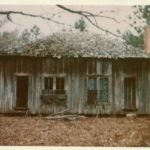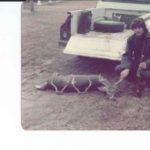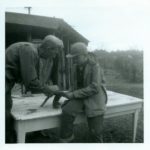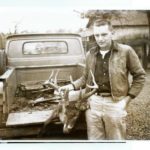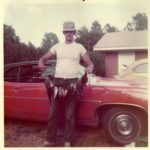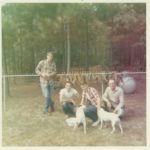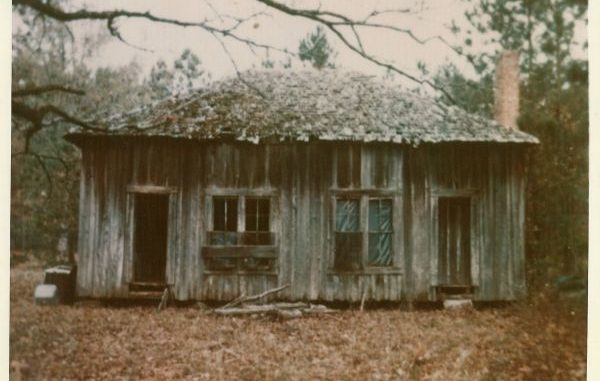
Today’s hunts in comfortable stands for abundant game have little in common with the good old days of the not-so-distant past.
My butt hurt and my back ached. For several hours I’d been sitting against a small holly tree watching a glade filled with rubs.
It was the last day of deer season, and I was determined to stay until dark to see if a buck would slip out.
Suddenly, out of nowhere, a head jerked up about 30 yards away, and I found myself in a staring contest with a large spike. After what seemed an eternity, the buck put its head back down, and I slowly raised my father’s 16-gauge Browning automatic and cut loose with a load of No. 1 buckshot.
Following the blood trail was easy, and I found my deer crumpled up not far away. Grabbing its spikes, I unashamedly let out a hearty Tarzan yell.
It was Jan. 2, 1971, and I had just killed my first buck at age 18.
I have often thought of that afternoon. Only recently had the deer herd in my part of Winn Parish reached a point where a hunter had a reasonable chance of shooting one.
Hunting was different then because such things as grunt calls, box stands, food plots, corn feeders and scent-free suits were unheard of. Forty years ago, killing a deer was something to brag about.
We senior citizens have seen many changes occur in Louisiana’s hunting sports. One is the sheer amount of game we have today, thanks to conservation efforts and changes in hunting habits.
Recently, while discussing squirrel hunting, my brother Larry commented, “We never killed many squirrels when we were kids because everybody hunted them all season long with dogs and shot them out.”
Truth is, back in the old days, if you even got a squirrel it was considered a good day. When I killed my first one, I was so excited I left the woods and ran home to show it off.
Not nearly as many people hunted the much-shorter deer season because deer were even scarcer than squirrels. I remember a time when if we saw a deer cross the road, we would go back for days just to look at the tracks.
The first deer I remember being killed around our home was a large 8-point my Uncle Rodger shot on the day after Christmas 1962.
It was several years later before anyone else in the family got another one.
Many other things have also changed over the years. There was a time when few people wore camouflage, and many did not have insulated clothes.
“I remember many times getting off work and going deer hunting in my oily, greasy work overalls — and killing deer,” friend and neighbor Bobby Joe Chandler recalled.
Back then our hunting philosophy could be summed up by one old timer’s advice: “If you stay downwind and keep still, deer don’t care what you wear.”
With no insulated coveralls or propane heaters, one had to improvise. Chandler remembers one creative way hunters took the chill off those frosty mornings.
“We used to take a coffee can, put a roll of toilet paper in it and soak it with alcohol and light it to stay warm,” he said. “It got me out of trouble many times.”
Today, many hunters spend all their time overlooking a food plot or corn feeder because their lease restricts them to one or two stands. When I started hunting, there were no leases in North Louisiana. Continental Can Company owned most of the timberland in our area and we were free to use it all.
Private land owners didn’t even post their property, and no one thought anything of walking behind a neighbor’s house to hunt.
Having access to so many thousands of acres, we often went to new areas, even though we knew nothing about the land. Larry recalled coon hunting with some high school friends on Big Creek one night and getting turned around in the unfamiliar woods.
“We walked all over that bottom trying to find our way out,” he said. “It was kind of spooky.”
Hunting laws also have changed over the years. Today we enjoy nearly 12 weeks of uninterrupted gun deer season and can take a doe any time we want. Shooting does (legally) was unheard of back then, until a single day of either-sex hunting was begun on a parish-by-parish basis in the late 1960s.
Many of us can also remember a time when there was a split deer season.
“Season didn’t even open until sometime up in November, and then there was a week or two break and another few weeks of hunting in December,” Larry said.
Traditionally, deer season closed the first Sunday in January.
One old-timey tradition that seems to have fallen by the wayside is not hunting on Sunday. I said earlier that I killed my spike on the last day of deer season. Actually, it was the day before — a Saturday — because we didn’t hunt on Sunday. In fact, hardly anyone in the Cypress Creek community hunted on the Sabbath. They might not go to church, but they didn’t hunt, either. It was just an unwritten rule.
Today, most people hunt alone, and then join their friends afterward for the post-hunt camaraderie. In the old days, hunting itself was much more of a social affair. We went out by ourselves whenever we wanted, but more often than not a hunt included fathers, brothers, cousins, uncles and a couple of squirrel dogs.
My parents, brothers and I used to take our feists out and combine family squirrel hunts with collecting lighter pine for the fireplace.
During group squirrel hunts, most of the grown-ups carried shotguns, but at least one person would have a .22 to reach the top of the tall swamp pines. Occasionally, if a treed squirrel was in plain view, the men would allow one of us kids to have the first shot. We almost always missed, and then a barrage of gunfire would erupt as the squirrel made a run for it. Surprisingly, the squirrel often made it to a hole unscathed, and then the laughing and good-natured ribbing would start.
Deer hunting was much the same. Everybody dog hunted — in fact, you were almost considered unsociable if you still hunted.
At daylight a gaggle of men and boys would gather at one of the dog owner’s houses. J.M and Paul Green, Willard Taylor and Mart Moffett were our dog men, and they would plan the drives.
Standers were placed near such well-known landmarks as the Gentry Place, Georgia Hill or Old House. We boys didn’t think much about it at the time, but learning local family history was a by-product of those deer hunts. Sadly, the old place names have fallen by the wayside in modern times.
Except for the occasional Model 94 Winchester or World War II surplus rifle, everyone carried shotguns on deer hunts. My family had a hodgepodge of guns to use. Larry had a 20-gauge Ithaca 37 that our parents got him for Christmas. He remembers the first buck he killed in the late 1960s.
“I shot it with No. 3 buckshot and paced off the distance at 58 yards,” he said.
I sometimes used Daddy’s Browning and even an old Marlin bolt-action 20-gauge goose gun, minus the clip, that came from my grandparents’ house. Buckshot was always the normal load, but sometimes we’d slip in a “bear ball” if we were covering a pipeline or long stretch of road. There were times when I was 12 or 13 that I even stood watch at a deer crossing armed with my Stevens single-shot .410 and a slug.
My first deer rifle was a commemorative issue Winchester Model 94 that Larry’s classmate Buddy Taylor won in a Dodson High School magazine-selling contest (in the old days not only could students win such guns, students and teachers often admired one another’s firearms in the parking lot).
Larry bought the rifle from Buddy for $50, and I bought it from Larry (Buddy later bought it back from me). The only time in my nearly 50 years of hunting that I have killed three bucks in a season was when I used that rifle in 1973.
Another significant change in hunting that has occurred in my lifetime is the use of four-wheel-drives and ATVs. The latter had not been invented when I started hunting, and four-wheel-drives were rarer than hen’s teeth.
When I was a boy, the only four-wheel-drive in Cypress Creek was an old jeep used by Mr. Ben Hutto to drive to Dugdemona River to check his trotlines and set hooks. One of my earliest memories is Mr. Ben driving up to my grandparents’ house in his jeep to show us a couple of Opelousas catfish he had caught. The largest one weighed over 30 pounds, and is still the biggest fish I have ever seen come out of the creek.
When we boys came of age, most of us bought cars for our first vehicle, and they were our primary hunting transportation. When we did have trucks, they were two-wheel-drives. Needless to say, getting stuck was a regular annoyance.
After you walked to the home of a friend or family member to call for help (no cell phones), the jacking up, digging and pushing began. No one complained, however, because everyone knew they would get stuck next week and would need help, as well.
Today, deer hunters spend most of their time in a comfortable box stand, but back in the day such things didn’t even exist. Oh, there were deer stands, but they were homemade leaners or 2×4 steps hammered to a tree leading up to a crude platform nailed around a fork.
Another technique was to find two small trees about 6 feet apart. Saplings were cut and nailed across the trees for a ladder, and two parallel poles were put at the top with a board across them for a seat. One had to be careful, however, because the green saplings would rot in a couple of years.
Bobby Joe Chandler had an even simpler system.
“A lot of times, if a tree limb was low enough to grab hold of, I’d just climb up the tree and stand on a limb about head high off the ground,” Bobby Joe said. “I also used to make a ladder out of cutting green poles, and then taking a hatchet to smooth down the sides so the green steps would fit flush and nail it all together. It wouldn’t be but maybe 6 or 7 feet tall, but you could lean it against a tree and climb up onto a limb to sit or stand on.”
I made a number of such stands in my younger days, and I used to come across their rotten remains. Fond memories of my youth would wash over me when I stood beside them. Ah, the good old days. They might be gone, but they’re not forgotten.
